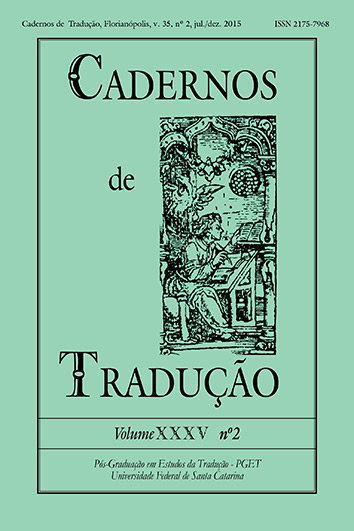Da fôrma às formas: metro, ritmo e tradução do hexâmetro
DOI:
https://doi.org/10.5007/2175-7968.2015v35n2p124Resumo
No presente artigo, pretendo discutir as possibilidades rítmicas do hexâmetro grego, demonstrando como esse metro, erroneamente reduzido a forma 5da+sp, reflete, na verdade, a articulação de vários cola métricos oriundos de diferentes tradições poéticas que se adequaram à fraseologia da poesia épica. Irei argumentar que as articulações rítmicas do hexâmetro são responsáveis por criar significados não triviais que precisam ser ressaltados na tradução, pois são parte integrante na construção do significado poético. Por fim, irei mostrar, por meio de três exemplos, como uma tradução que atente para a natureza polirrítmica do hexâmetro poderia ser levada a cabo.
Referências
BAKKER, E. J. Poetry in Speech: Orality and Homeric Discourse. Ithaca/ London: Cornell University Press, 1997. ISBN 9780801432958.
BARKER, A. Greek Musical Writings: Volume 2, Harmonic and Acoustic Theory. Cambridge: Cambridge University Press, 2004. ISBN 9780521616973.
BAUMAN, R.; BRIGGS, C. L. Poetics and performance as critical perspectives on language and social life. Annu. Rev. Antropol., v. 19, p. 59-88, 1990.
[informação sobre o autor]
CORRÊA, P. D. C. Hamonia: mito e música na Grécia antiga. 2ª. São Paulo: Humanitas, 2008. ISBN 9788577321025.
EVANS, V. A Glossary of Cognitive Linguistics. Edinburgh: Edinburgh University Press, 2007. ISBN 9780748622801.
FINNEGAN, R. Oral Traditions and the Verbal Arts: A Guide to Research Practices. Londres: Routledge, 1992:2003. ISBN 9781134945399.
FRÄNKEL, H. Der homerische und der kallimachische Hexameter. In: (Ed.). Wege und Formen frühgriechischen Denkens, 1955. p.100-56.
GENTILI, B. Poetry and Its Public in Ancient Greece: From Homer to the Fifth Century. Baltimore and London: Johns Hopkins University Press, 1990. ISBN 9780801840197.
GENTILI, B.; LOMIENTO, L. Metrica e ritmica. Milão. 2003.
GORKY, M.; MAYAKOVSKY, V.; MILLER, A. On the Art and Craft of Writing. University Press of the Pacific, 2000. ISBN 9780898750409.
HAGEL, S. Ancient Greek Music: A New Technical History. Cambridge: Cambridge University Press, 2009. ISBN 9780521517645.
HASLAN, M. Stesichorean Metre. Quaderni Urbinati di Cultura Classica, v. 17, p. 7-57, 1974.
______. The Versification of the New Stesichorus (P. Lille 76 abc). GRBS, v. 19, p. 29-57, 1978.
HAVELOCK, E. The Oral-literate equation: a formula for the modern mind. In: OLSON, D. R. e TORRANCE, N. (Ed.). Literacy and Orality. Cambridge: Cambridge University Press, 1991. p.11-27.
HAVELOCK, E. A. Prefácio a Platão. Campinas: Papirus, 1996. ISBN 853080368X.
KIRK, G. S. et al., Eds. The Iliad: A Commentary. The Iliad: A Commentary. Cambridge: Cambridge University Press, v.v. 3, The Iliad: A Commentaryed. 1993.
KORZENIEWSKI, D. Griechische Metrik. Die Altertumswissenschaft. Darmstadt: Wissenschaftliche Buchgesellschaft 1968.
MEILLET, A. Les Origines Indo-européennes des Mètres Grecs. Paris: Les Presses Universitaires de France, 1923.
NAGY, G. The best of the Achaeans. Johns Hopkins University Press, 1979. ISBN 9780801860157.
______. Pindar's Homer. Baltimore: The Johns Hopkins University Press, 1990. Disponível em: < http://www.press.jhu.edu/books/nagy/PH.html >.
NIDA, E. A. Translating a text with a long and sensitive tradition. In: SIMMS, K. (Ed.). Translating Sensitive Texts: linguistic aspects: Rodopi, 1997. p.333. (Approaches to Translation Studies).
PAGLIARO, A. Aedi e Rapsodi. In: (Ed.). Saggi di Critica Semantica. Messina, Florença, 1953. p.3-62.
SCHLEGEL, A. W. Über die Bhagavad-gita. In: HEIDERMANN, W. (Ed.). Clássicos da Teoria da Tradução: alemão-português. 2ª edição, revisada e ampliada. Florianópolis: UFSC/Núcleo de Pesquisa em Literatura e Tradução, v.1, 2010. p.120-127. (Clássicos da Teoria da Tradução).
SICKING, C. M. J. Griechische Verslehre. Munique: C.H. Beck'sche Verlagsbuchhandlung, 1993.
SNELL, B. Griechische Metrik. 4. Göttingen: Vanderhoeck & Ruprecht, 1982. ISBN 3525253184.
TÁPIA, M. Questões de equivalência métrica em tradução de poesia antiga. Revista Letras, n. 89, p. 17, 2004. ISSN 0100-0888.
THIONG'O, N. Penpoints, Gunpoints, and Dreams: Towards a Critical Theory of the Arts and the State in Africa. Oxford University Press, USA, 1998. ISBN 9780198183907.
THOMAS, R. Oral Tradition and Written Record in Classical Athens. Cambridge: Cambridge University Press, 1989. ISBN 0521350252.
______. Literacy and Orality in Ancient Greece. Cambridge Cambridge University Press, 1992. ISBN 9780521377423.
WEST, M. L. Greek metre. Clarendon Press, 1982. ISBN 9780198140184.
______. Ancient Greek Music. Oxford: Oxford University Press, 1992.
ZUMTHOR, P. Introdução à Poesia Oral. Belo Horizonte: UFMG, 2010. ISBN 9788570417596.
Downloads
Publicado
Como Citar
Edição
Seção
Licença
Copyright (c) 2015 Cadernos de Tradução

Este trabalho está licenciado sob uma licença Creative Commons Attribution 4.0 International License.
Autores têm autorização para assumir contratos adicionais separadamente, para distribuição não exclusiva da versão do trabalho publicada nesta revista (ex.: publicar em repositório institucional ou como capítulo de livro, com reconhecimento de autoria e publicação inicial nesta revista).





















































